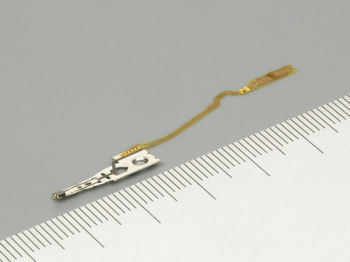200 GB 2.5" hard drives may be feasible in 2H 2006
Tokyo (Japan) - A developer of parts and technologies for magnetic recording devices, as well as supplier of parts for hard drive manufacturers, announced this morning it will be demonstrating an implementation of a perpendicular hard disc drive recording scheme made feasible through a new type of thin-film recording head. ALPS Technologies is promising it will demonstrate, at a private trade conference this May, a recording head capable of boosting areal densities to 170 Gb/in2, that will be ready for production in the second half of this year.
ALPS Technologies' TuMR thin-film hard disk drive recording head. (Courtesy ALPS Technologies)
ALPS' description of its own technology, on first glance, doesn't sound like anything new. Perhaps with little or no guidance as to the meaning of English words being leveraged as acronyms, ALPS' trademarked TuMR (Tunneling Magneto Resistive) thin-film head element is described as sandwiching an insulating layer between two highly resistive film layers, causing electric current to transcend through the insulator - which is how these things tend to work, generally. And ALPS claim of 170 GB/in2 doesn't seem a chart-topper either, at least at first. What raises expectations is that promise of production in the second half of the year.
In March 2005, Hitachi raised hopes with an announcement of a future implementation of its own patented perpendicular recording technology, with hopes of 230 GB/in2 areal densities. But drives that pack that much, that close together, have yet to see production; at present, Seagate leads the pack in terms of perpendicular implementations currently in production, with areal densities of 132 Gb/in2. At the 2.5" form factor, such Seagate drives are capable of 80 GB per platter or 160 GB total.
ALPS is a known supplier of parts to, among others, Western Digital. If it can ramp up production of TuMR thin-film heads, it could conceivably enable WD and other clients to build 100 GB per platter drives in the 2.5" form factor, without having to invest too much in R&D.
Get Tom's Hardware's best news and in-depth reviews, straight to your inbox.
